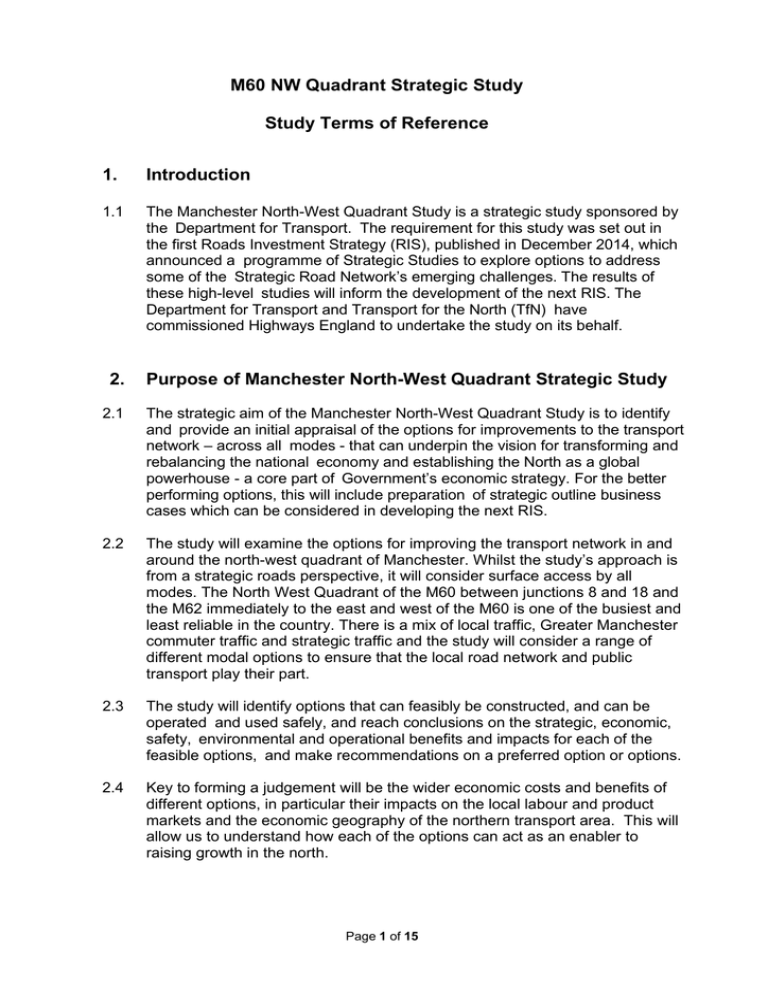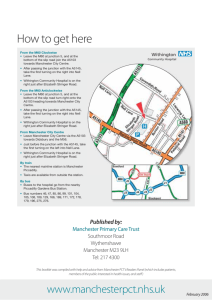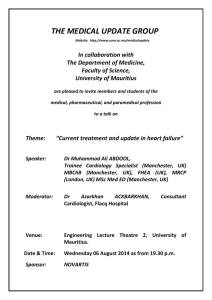Terms of reference for the Manchester north-west quadrant
advertisement

M60 NW Quadrant Strategic Study Study Terms of Reference 1. Introduction 1.1 The Manchester North-West Quadrant Study is a strategic study sponsored by the Department for Transport. The requirement for this study was set out in the first Roads Investment Strategy (RIS), published in December 2014, which announced a programme of Strategic Studies to explore options to address some of the Strategic Road Network’s emerging challenges. The results of these high-level studies will inform the development of the next RIS. The Department for Transport and Transport for the North (TfN) have commissioned Highways England to undertake the study on its behalf. 2. Purpose of Manchester North-West Quadrant Strategic Study 2.1 The strategic aim of the Manchester North-West Quadrant Study is to identify and provide an initial appraisal of the options for improvements to the transport network – across all modes - that can underpin the vision for transforming and rebalancing the national economy and establishing the North as a global powerhouse - a core part of Government’s economic strategy. For the better performing options, this will include preparation of strategic outline business cases which can be considered in developing the next RIS. 2.2 The study will examine the options for improving the transport network in and around the north-west quadrant of Manchester. Whilst the study’s approach is from a strategic roads perspective, it will consider surface access by all modes. The North West Quadrant of the M60 between junctions 8 and 18 and the M62 immediately to the east and west of the M60 is one of the busiest and least reliable in the country. There is a mix of local traffic, Greater Manchester commuter traffic and strategic traffic and the study will consider a range of different modal options to ensure that the local road network and public transport play their part. 2.3 The study will identify options that can feasibly be constructed, and can be operated and used safely, and reach conclusions on the strategic, economic, safety, environmental and operational benefits and impacts for each of the feasible options, and make recommendations on a preferred option or options. 2.4 Key to forming a judgement will be the wider economic costs and benefits of different options, in particular their impacts on the local labour and product markets and the economic geography of the northern transport area. This will allow us to understand how each of the options can act as an enabler to raising growth in the north. Page 1 of 15 3. Background 3.1 The North-West Quadrant of Greater Manchester contains many strategic routes which provides orbital connectivity around, and into, Manchester and allows movements between east and west via the M62. 3.2 Historically, the Manchester outer ring road – the M60 – forms part of the M62, providing strategic road connectivity between the North Western and Yorkshire cities. The North West Quadrant of the M60 between Junctions 8 and 18 and the M62 immediately to the east and west of the M60 is one of the busiest and least reliable in the country. There is a mix of local traffic, Greater Manchester commuter traffic and long-distance traffic. 3.3 Proposals to improve the capacity of the M60 between Junctions 8 and 20 by making it a smart motorway and all-lane running on the M62 between Junctions 18 and 20 were announced as three separate schemes in the Spending Review 2010 (SR10). Following the SR10 announcement, a study into the performance of the existing network was conducted to ensure that the proposals for the M60 Junctions 8 to 12, M60 Junctions 15 to 12 and M60 Junctions 18 to 20 addressed the issues that exist on the network. The outcome of the study concluded that the three individual schemes did not address all the key congestion points on this section of the road network and a review of the operational concept was required. The review concluded that a corridor approach which included introducing a managed motorway operational regime and to all links between M60 Junction 8 and M62 Junction 20 would address the key congestion points as well as offering an opportunity to improve on the benefits previously identified. 3.4 These individual schemes were subsequently combined into one scheme, M60 Junction 8 to M62 Junction 20 Manchester Managed Motorways in February 2013. The Highways Agency consulted on the implementation of variable mandatory speed limits for the M60 Junction 8 to M62 Junction 20 smart motorway scheme in November 2013. All Lane running would also be introduced between Junctions 18 and 20 on M62. Highways England’s Delivery Plan 2015 – 2020 anticipates that this will be open to traffic in 2017/18. 3.5 Significant growth in the region, including the development of Liverpool2, a major deep sea terminal and significant developments underway or planned including Port Salford, Trafford Quays and Carrington and the emerging freight strategy for Transport for the North will continue to add pressure the transport infrastructure in and around the north-west quadrant of Manchester. 3.6 In April 2014 the Highways Agency published 18 route strategy evidence reports1, including the South Pennines Route Strategy evidence report2. This was followed in March 2015 by Highways England’s publication of 18 route strategies for the strategic road network (SRN)3, which helped inform the development of the RIS for Road Period 1 (2015/16 – 2019/20)4. Page 2 of 15 3.7 In addition, in March 2015, the Northern Transport Strategy (NTS), set out plans to transform Northern growth, rebalance the country’s economy and establish the North as a global powerhouse5. Transport is a fundamental part of achieving these goals. The shared vision set out in the NTS is consistent with RIS1. It commits to development of the next generation of major road improvements to dramatically improve east-west connectivity with the shared aim to address remaining strategic bottlenecks that will otherwise constrain the North’s growth potential. 3.8 In addition to improvements on the SRN, a number of major transport schemes are being progressed, including the Western Gateway Infrastructure Scheme, Bolton- Salford Quality Bus Network and Trafford Park Metrolink. A freight strategy is also being developed to support the aims of the Northern Transport Strategy. 3.9 The M60 corridor also has a large number of residential dwellings that are exposed to poor air quality, including some of the highest concentrations of Nitrogen Dioxide in the country. The RIS stated the aspiration of zero breaches of air regulations across the network by 2040. Highways England are currently trialling air quality retrofit measures between Junctions 18 and 20 of the M62. _____________________________________ 1 2 3 https://www.gov.uk/government/publications/route-based-strategies-evidence-reports https://www.gov.uk/government/uploads/system/uploads/attachment_data/file/365291/South_Pennines.pdf https://www.gov.uk/government/publications/route-strategies-april-2015-march-2020 4 https://www.gov.uk/government/uploads/system/uploads/attachment_data/file/408514/ris-for-2015-16-road- period-webversion.pdf 5 https://www.gov.uk/government/uploads/system/uploads/attachment_data/file/427339/the-northern-powerhousetagged.pdf Page 3 of 15 4. Study Objectives 4.1 The specific objectives of the study are to: i. Review previous study work, other relevant data, and current investment plans to understand current performance and constraints of the existing road infrastructure, and confirm the strategic case for considering further investment. ii. Identify options for increasing capacity and resilience on this part of the network across all surface transport modes. Understand the operational benefits and challenges of the different options. This will need to reflect the localised transport activity features of the area considered by the study, including travel demand linked to growth of the Regional Centre, including Salford Quays, and development of Trafford Quays; and intermodal traffic growth associated with Port Salford, as well as recognising wider priorities of stimulating the economy in the north of England. iii. Appraise transport benefits using WebTAG methodology and wider economic benefits using an approach consisted with the approach set out in the Transport Investment and Economic Performance Report and the Department for Transports response on Understanding and Valuing the Impacts of Transport Investments. The benefits assessment will need to encompass analysis of the congestion-relief, reliability, safety, and environmental outcomes including: • • • • • • • • an assessment of the impacts, benefits and costs of each transport improvement option, considering its strategic and economic case together with its effects on traffic and congestion, road safety, and the environment; an assessment of the impacts and benefits of scheme options on other sections of the M60 and strategic and local trans-Pennine roads including, but not limited to, the M62; an assessment of the potential improvements to the SRN affecting traffic on the local road network. This should include identifying areas where improvements could alleviate pressures and issues on the network (including issues likely to be created or exacerbated by expected growth) or create additional problems and congestion. The impacts of/on improved rail connectivity across the LiverpoolManchester- Leeds corridor from Northern Hub and longer term Trans North/HS3 plans. The impacts of/on long term growth plans for Manchester Airport and ports in the region ; consideration of the impact of each option on local and regional labour markets, wages, employment levels, and skills; on the cost of supply and on the benefits of greater collaboration and economies of scale; consideration of the impact of each option on current and future land use and what this means to the local and regional economy as well as to the environment and communities; consideration of the consequences of the scheme in terms of Page 4 of 15 • • • increased investment in the region and the most likely form which this would take; an assessment of the degree to which impacts and benefits are truly additional and whether options will have a negative impact on other areas in terms of reduced employment, investment and growth; calculation of the estimated cost of each option and the approximate time for its delivery, giving regard to any option that will be a Nationally-Significant Infrastructure Project (NSIP) and will therefore be delivered under Planning Act 2008 powers; and identifying the risks and opportunities associated with each option, including those relating to the development process, construction, commissioning, operation and use, maintenance, security and safety. iv. A key part of the study will be in understanding how different options impact on the Northern Transport area including Manchester, Leeds and Liverpool. This will include consideration of the needs of and impact on the M62 to provide additional resilience and capacity. Options and analysis within the study will need to reference the other strategic studies and reflect wherever possible the key findings of the other northern Strategic Studies (Trans-Pennines Tunnel and Northern Trans Pennine Studies); consider strategic risks arising from three major complex projects being undertaken within the same broad Transpennine area potentially within the same Roads Period; and the coordination of scheme ‘roll-out’. It will also need to have due regard to the impact of traffic demand is road infrastructure schemes including Mersey Gateway, M56, A556 and A6. v. Have reference to and reflect wherever possible the key findings of the other northern Strategic Studies (Trans Pennine Tunnel and the Northern TransPennine Study). Specifically, understand the interdependencies between the potential options arising from the Trans Pennine Tunnel Strategic Study and the Northern Trans-Pennine, to include: • Understanding the implications of the timing and phasing of potential schemes for the three study locations, to minimise impact on the performance of the network during the build phases; • Identification of opportunities for synergy or optimal sequencing of major road and rail works involved in, and options for mitigating strategic risks arising from, three major complex projects being undertaken within the same function geography potentially within the same Roads Period. Page 5 of 15 5. Geographic Scope 5.1 The geographic scope of the study will include the M60 from junctions 8-20 and the M62 from junctions 9-12. However the potential impact on labour markets will extend well beyond this area. It will also need to take account of the requirements of the emerging freight strategy for TfN and the development of Liverpool2, a major deep sea terminal. 5.2 A map of the proposed approximate geographical scope of the study is included at Figure 1 below. 6. Modal Scope 6.1 The study will be multi modal in scope and will need to understand existing investment proposals on both the strategic and local authority road networks, and on public transport. The study will need to consider at stage 2 the possibility that other modal solutions such as local bus, coach and rail services can address the strategic objectives of the study (including where either existing infrastructure or planned improvements fulfil some of the studies objectives). Figure 1 Page 6 of 15 7. Study Stages 7.1 The study will be completed in three stages which are set out below. The study will be reviewed at the end of stages one and two to confirm the value of proceeding and review the scope of the subsequent phases of work. Stage 1 Review of existing evidence and provide advice on the strategic and economic case for improved capacity on the M60 and M62 in the North West Quadrant of Manchester. 7.2 The study will review any relevant evidence (including wider economic evidence of labour markets, industrial structure in different geographic areas). The evidence will include that gathered through the Highways Agency’s South Pennines route strategy, together with evidence from any other relevant study work and analysis related economic development and connectivity to form a view as to the nature and scale of current and future performance of the relevant routes. Gaps in evidence will be reviewed with Highways England, the Department for Transport and TfN. 7.3 Having established the availability of existing transport models, the study will summarise this evidence and reach a preliminary view on the strategic and economic benefits for improved connectivity in the region. Stage 2 Identify options for further assessment for improved capacity on the M60 and M62 in the NW Quadrant of Manchester, provide an option assessment, summarising their technical and operational feasibility. 7.4 Once the strategic case has been confirmed, the study will then review the options considered in previous study work, identify any further options, and reach a view for each of these options on their technical and operational feasibility. 7.5 The study will be required to cover the range of issues set out in the aims and objectives. The study will be required in stage 1 of the analytical work to systematically reach a view, based on the modelling available on which of the options examined should be taken through subsequent benefits assessment work. 7.5 These will cover impact on traffic levels on the M60 and M62 but also the wider benefits to the north including to growth, employment, businesses and impacts across groups and areas. Page 7 of 15 Stage 3 Understand the benefits arising from the potential options for increased capacity. 7.6 Once a confirmed set of deliverable and feasible options have been identified, this stage should comprise the production of benefits assessments covering the areas set out in the aims and objectives, including detailed costings for each scheme option. The study will need to consider a range of individual investment proposals and potentially combinations of investment proposals. 7.7 These will cover traffic, environment, safety and resilience and also the wider benefits to the north including to growth, employment, businesses and impacts across groups and areas. 7.8 Where the recommendations can be broken down into several discrete elements, this section should detail both the while route analysis of the total value of the package of works and separate analysis demonstrating the individual cost and contributions of different sections. 8. Outputs and Milestones 8.1 The following key milestones will be established for the study. These milestones will be kept under review as the study progresses, and are subject to amendment as and when required. Deliverables Completion Date • Review of previous evidence and other study conclusions and initial report to the Programme Board to confirm the high-level strategic case for transport improvements. • Publication of an interim report setting out the strategic and economic case for the transport improvements., Identify a range of potential investment options for the transport network in and around the north-west quadrant of Manchester. March 2016 Report to the Programme Board setting out the full findings of the study, as an update to the published interim report, to include full assessment of the benefits of the options. 16 October 2016 • • Page 8 of 15 January 2016 May 2016 9. Study Governance 9.1 The Manchester NW Quadrant Strategic Study is a strategic study sponsored by the Department for Transport and TfN, which is being undertaken by Highways England. The Senior Responsible Officer (SRO) for the study is Karen Wilkinson, Senior Policy Adviser at the Department for Transport. 9.2 Governance of the study will be provided by the Northern Studies Programme Board. The Northern Studies Programme Board will set the overall direction of the study at each of its stages and will review and approve the outputs of study work, and the Consultant will be expected to report to, and provide information for, this Board. The Programme Board will include representatives from the Department for Transport, Highways England and Transport for the North. 9.3 The role of the Programme Board will be to: • Provide strategic direction for the programme of studies and monitor key milestones; • Monitor/validate progress against plan and review significant risks and issues; • Decide on the frequency and level of detail to be reported to Ministers; • Provide advice to project managers regarding issues that arise as part of the individual studies; • Review and approve the study outputs; and • Take account of analytical assurance provided by the RIS futures analytical working group 9.4 The day to day control of the study will be undertaken by a project board. The project board will provide strategic oversight to the study and will confirm that the terms of reference for the study are being addressed in the delivery of the Services. It will be chaired by the SRO, and will include other representatives from, the Department for Transport, Highways England and Transport for the North. 9.5 The role of the Project Board will be to: • Ensure agreement to the scope of the study, the aims, timings and outputs of the study, and agree any amendments to the study’s activities as it progresses; • Provide day to day oversight of the study; • Take decisions as necessary throughout the life of the study and decide which decisions should be escalated to the Programme Board, and approve draft outputs to be considered by the Programme Board; • Monitor progress against the plan and review significant risks and issues. 9.6 As the study progresses there may be a need to establish specific technical or working groups to take forward defined activities. Decisions on the Page 9 of 15 establishment and membership of such groups would be for the project board to consider. 9.7 Figure 2 illustrates the proposed governance arrangements for the Northern Trans-Pennine Study and its relationship with the other ongoing strategic studies. 10. Stakeholder Reference Group 10.1 Given the broad range of stakeholder interests in the study a Stakeholder Reference Group will be established by the Department for Transport. 10.2 The main role of the reference group will be to ensure stakeholders’ views are captured and considered during the study process, particularly at times of the development of key outputs. 10.3 The establishment of the reference group will allow stakeholder organisations to be aware and feed into the work of the study and allow representation from other organisations. 10.4 The membership of the reference group will be confirmed at the end of stage 1 of the study, and is likely to include LEPs, local authorities (including planning authorities), environmental NGOs, other transport associations and business interest groups. The membership of this group will be kept under review as the study progresses to ensure that it continues to capture stakeholder views throughout the study process. 10.5 Transport for the North will chair the Stakeholder Reference Groups for the Northern Trans-Pennine, Manchester North-West Quadrant and Trans-Pennine Tunnel studies. Page 10 of Figure 2



